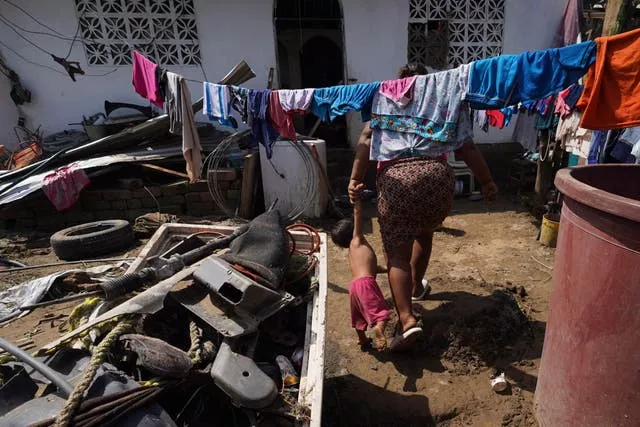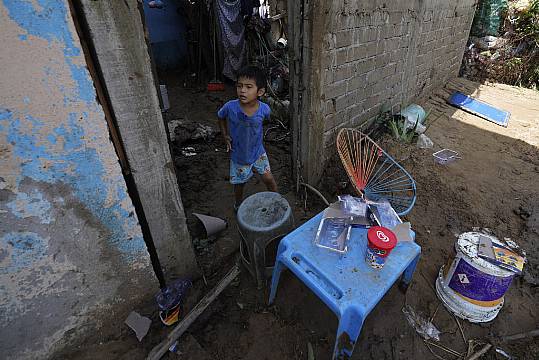Survivors of the Category 5 storm that killed at least 27 people and devastated Mexico’s resort city of Acapulco are becoming increasingly desperate amid a slow government response.
There are fears that repair efforts will focus on the city’s economic engine of tourism, instead of helping the neediest, in the wake of Otis.
Despite hopes of incoming aid by many in Acapulco, the coastal city of one million once known for its beachside glamour was still in a state of complete chaos by Thursday night.

Entire walls of beachside high rises were ripped clean off, and hundreds of thousands of homes remained without electricity.
People lacking even the most basic resources were emptying stores out of everything from food to toilet paper.
Miguel Angel Fong, president of the Mexican Hotel Association, told the AP that 80% of the city’s hotels were damaged.
Meanwhile, dozens of tourists, tired of waiting for buses out of the city, walked along the narrow pavements through the long car tunnel under the mountain dividing the port from the rest of the city.

The Pacific storm had strengthened with shocking swiftness before slamming into the coast early on Wednesday, and the Mexican government deployed around 10,000 troops to deal with the aftermath. But equipment to move tonnes of mud and fallen trees from the streets was slow in arriving.
Mexico’s President Andres Manuel Lopez Obrador said Otis had toppled every power-line pole in the zone where it hit on Wednesday, leaving much of the city of without electricity.
Otis turned from mild to monster in record time, and scientists were struggling to determine how – and why – they did not see it coming.
Acapulco’s municipal water system was down and around half a million homes lost power. Mr Lopez Obrador said that restoring power was a top priority, but by Thursday evening there were still 250,000 homes and businesses with no electricity.

Brown floodwaters extended for miles in some areas. Many residents were taking basic items from stores to survive. Others left with pricier goods, in widespread rampages through the area’s stores.
As mobile phone signals began to return to some parts of the city, residents organized themselves with the help of friends and relatives living in other parts of Mexico and the United States.
They joined together using online messaging platforms like WhatsApp. On Thursday there were some 1,000 people in 40 chats, which only continued to grow in number throughout the day.
They shared photos of flooded areas and tips for finding mobile phone signals, while asking for information about loved ones that they had not heard from. Others share photos of papers full of names of survivors taking refuge in shelters.

Acapulco’s police chief Luis Enrique Vázquez Rodríguez said on Thursday they could do little to stop people from emptying local stores or speed up traffic caused by mud and fallen trees, which has left much of the city paralyzed.
“We don’t have the capacity to stop looting because there’s so many people,” he said. “This is a completely extraordinary situation.”
Some residents said it could take a year for Acapulco to recover; with no power, petrol, scant mobile phone coverage and hotels wrecked by the hurricane, the task seemed impossible.
Marketing expert Antonio Esparza was one of the few optimistic ones, even as he sat trapped in the snarled traffic of the aftermath.
“This is going to improve Acapulco, because it will force the government to pay attention,” he said.

It took nearly all of Wednesday for authorities to partially reopen the main highway connecting Acapulco to the state capital Chilpancingo and Mexico City.
The vital ground link allowed dozens of emergency vehicles, personnel and trucks carrying supplies to reach the battered port.
Acapulco’s commercial and military airports were still too badly damaged to resume flights, though Mr Lopez Obrador said the plan was to establish an air bridge to move in resources.
Acapulco is at the foot of steep mountains. Luxury homes and slums alike cover the hillsides with views of the glistening Pacific Ocean.
Once drawing Hollywood stars for its nightlife, sport fishing and cliff diving shows, the port has in recent years fallen victim to competing organised crime groups that have sunk the city into violence, driving away many international tourists.







